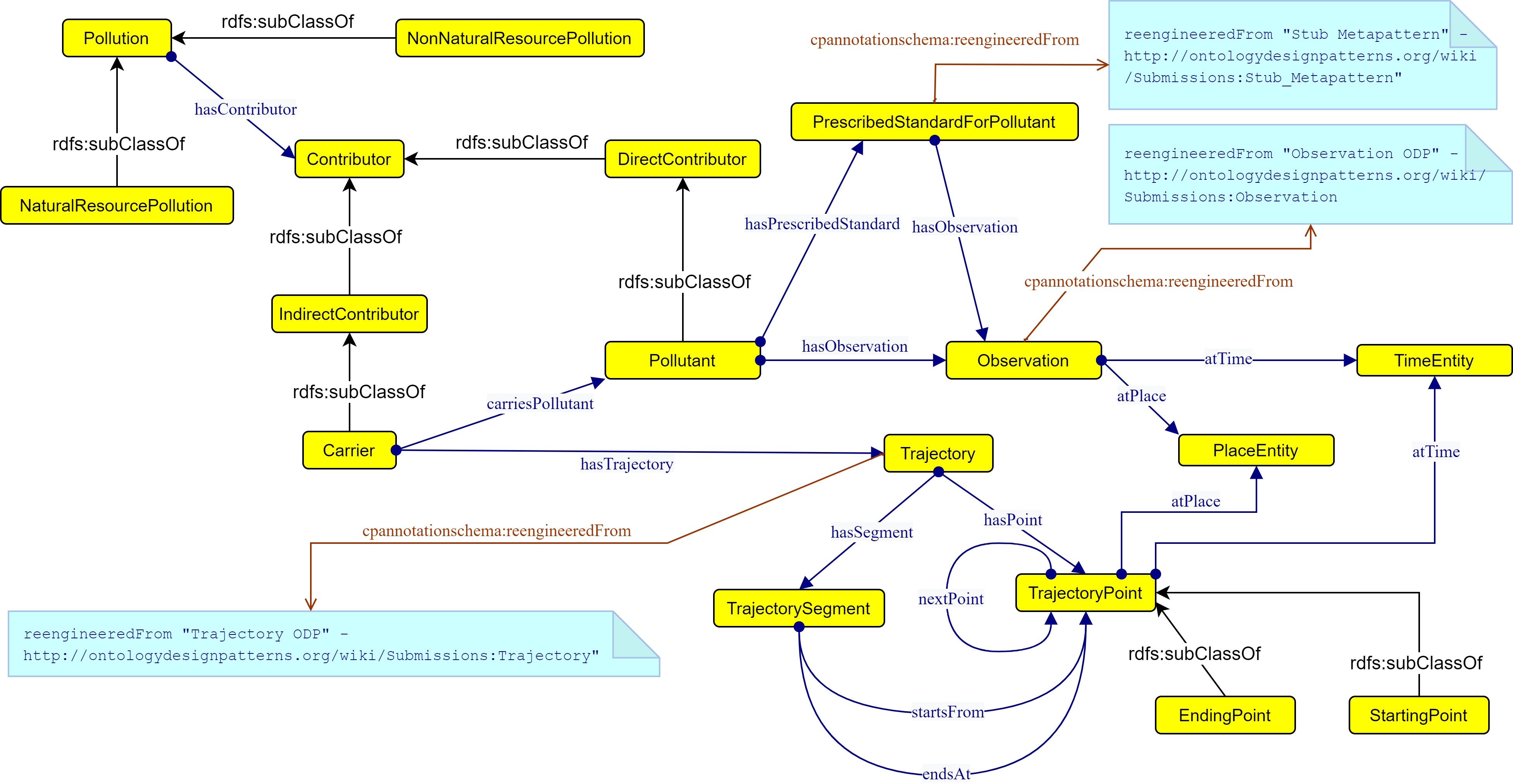From Odp
This pattern has been certified.
Related submission, with evaluation history, can be found here

| If you are a member of quality committee please visit the
evaluation section
If you are author of this proposal or you want to contribute to this pattern's review, you can:
In general, it could be useful to visit the evaluation section to have information about the evaluation process of this proposal
Current revision ID: 14244
|
Graphical representation
Diagram
General description
| Name:
| Pollution
|
| Submitted by:
| SaadAhmad
|
| Also Known As:
|
|
| Intent:
| The Pollution ontology design pattern (ODP) intends to model the pollution, the pollutants and their observations at various spatio-temporal points. It also captures the information about the various direct and indirect sources of pollution. The Pollution ODP makes use of Trajectory, Observation and Stub-Metapattern ODPs.
|
| Domains:
|
|
| Competency Questions:
|
- 1. What are the contributors of the pollution? 2. What is the pollutant concentration at a particular time and place? 3. What are the carriers that contributed to the pollution? 4. What are the pollutants carried by a carrier? 5. What are the prescribed standards for a particular pollutant? 6. What is the trajectory of a carrier for a pollutant?
|
| Solution description:
| The pollution ODP uses Trajectory, Observation and Stub_Metapattern ODP at its core to represent pollution. Pollution is the core concept in the ODP and is connected to multiple contributors, which can have spatio-temporal characteristics.
|
| Reusable OWL Building Block:
| https://github.com/kracr/aq-structured-platform/blob/main/Ontology/PollutionODP/PollutionODP.owl.xml (0)
|
| Consequences:
| This ODP is a first for modelling pollution and is an improvement over some of the ontologies that focus on very specific aspects of pollution. It allows to model pollution sources as well as monitor the pollution at spatio-temporal points.
|
| Scenarios:
| 1. Which pollutant sources contribute to a wind stream which flows into a place? 2. What was the precipitation level on 23rd April at a particular location? 3. What locations have an AQI beyond a certain threshold in a certain region in a given month?
|
| Known Uses:
|
|
| Web References:
|
|
| Other References:
|
|
| Examples (OWL files):
|
|
| Extracted From:
|
|
| Reengineered From:
|
|
| Has Components:
|
|
| Specialization Of:
|
|
| Related CPs:
|
|
Elements
The Pollution Content OP locally defines the following ontology elements:
Authors (owl:AnnotationProperty)
 Authors page
Authors page atPlace
atPlace (owl:ObjectProperty)
 atPlace page
atPlace page atTime
atTime (owl:ObjectProperty)
 atTime page
atTime page endsAt
endsAt (owl:ObjectProperty) Connects a segment to the point it ends at.
 endsAt page
endsAt page hasPoint
hasPoint (owl:ObjectProperty) Relating the trajectory to each of its points.
 hasPoint page
hasPoint page hasSegment
hasSegment (owl:ObjectProperty) Relating the trajectory to each of its segments.
 hasSegment page
hasSegment page hasTrajectory
hasTrajectory (owl:ObjectProperty) Anything that has a trajectory can use this property to connect it to the trajectory instance
 hasTrajectory page
hasTrajectory page nextPoint
nextPoint (owl:ObjectProperty) Relates one point to the immediately following point in the sequence.
 nextPoint page
nextPoint page startsFrom
startsFrom (owl:ObjectProperty) Connects a segment to the point it starts from.
 startsFrom page
startsFrom page Carrier
Carrier (owl:Class) Represents streams which carry pollutants to a particular place.
 Carrier page
Carrier page DirectContributor
DirectContributor (owl:Class) Represents concepts which directly represent pollution. For example the concentration of pollutants at a particular spatio-temporal point.
 DirectContributor page
DirectContributor page IndirectContributor
IndirectContributor (owl:Class) Represents concepts which indirectly contribute to pollution of a place. These do not directly represent pollution but have properties which can affect the pollution, for example by changing the concentration of pollutants at a spatio-temporal point.
 IndirectContributor page
IndirectContributor page NaturalResourcePollution
NaturalResourcePollution (owl:Class) Represents pollution on natural resources. Which means the pollution that affects natural resources like air, water, land, etc.
 NaturalResourcePollution page
NaturalResourcePollution page NonNaturalResourcePollution
NonNaturalResourcePollution (owl:Class) Represents pollution which does not represent natural resource. Examples include, sound, light, space debris, radioactive pollution, thermal pollution.
 NonNaturalResourcePollution page
NonNaturalResourcePollution page Observation
Observation (owl:Class) Observation represents a spatio-temporal observation of pollutants under time and place parameters.
 Observation page
Observation page Pollutant
Pollutant (owl:Class) Represents various pollutants which contaminate the environment and directly represnt/contribute to pollution. Additionally a carrier's trajecectory point may pick up pollutants from a spatio-temporal point, in which case, it is represented by the sub-property carriesPollutant.
 Pollutant page
Pollutant page Pollution
Pollution (owl:Class) Represnents the notion of Pollution which includes observation of pollutants at spatio-temporal points or the contributors to the pollution which may be spatio-temporal in nature.
 Pollution page
Pollution page Trajectory
Trajectory (owl:Class) Represents a trajectory of points. Examples include drainage/sewage trajectory or air stream trajectory.
 Trajectory page
Trajectory page TrajectoryPoint
TrajectoryPoint (owl:Class) A collection of spatio-temporal points represents a trajectory
 TrajectoryPoint page
TrajectoryPoint page TrajectorySegment
TrajectorySegment (owl:Class) A subset of spatio-temporal trajectory points represent a TrajectorySegment
 TrajectorySegment page
TrajectorySegment page Additional information
This ontology is an attempt at a ODP designed to model Pollution. Pollution can be defined as
Scenarios
Scenarios about Pollution
No scenario is added to this Content OP.
Reviews
Reviews about Pollution
There is no review about this proposal.
This revision (revision ID 14244) takes in account the reviews: none
Other info at evaluation tab
Modeling issues
Modeling issues about Pollution
There is no Modeling issue related to this proposal.
References
Add a reference



